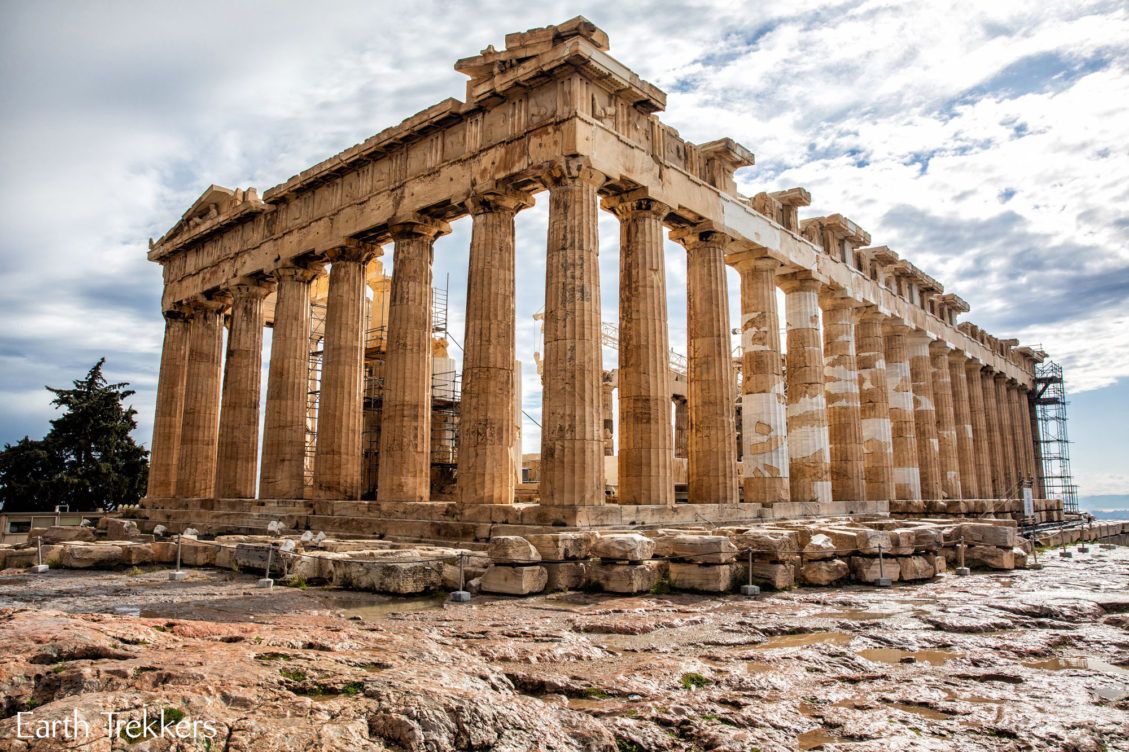Today is International Transgender Day of Visibility, and I am here for it. While I'm a cis-woman, I know some awesome transgendered or otherwise genderqueer individuals, and I want to celebrate their awesomeness today! In true Baring the Aegis style, I'll do this by sharing the myths of some intersexed, gender-shifting, gender-merging or otherwise genderqueer individuals.
I must, of course, start with Hermaphroditos (Ἑρμαφρόδιτος), who is the child of Aphrodite and Hermes. He became a minor deity of bisexuality and effeminacy, and was portrayed as a female figure with male genitals. In the myth told by the Roman poet Ovid, Hermaphroditos was born fully male. As a young man, he wandered the lands and encountered a nymph, Salmacis (Σαλμακίς), in her pool. Salmacis fell for the boy right away, tried to seduce him. Hermaphroditos rebuked her, but she still jumped him when undressed for a bath in her pool. As he tried to fight her off, Salmacis cried out for the Theoi to let them stay forever merged--upon which the Theoi agreed: the two fused together, becoming the first hermaphrodite.
I've mentioned before that Ovid's myths aren't reflective of ancient Hellenic mythology--and in Hellenic myth, Hermaphroditos was either born with both male and female part, or he was simply very feminine in that he had pale skin and was very delicate, while still possessing the strength of a male. Especially in the latter case, there is a beautiful gender duality in Hermaphroditos that I much appreciate.
Ovid's 'Metamorphoses' is the source for a few other Hellenic-inspired Roman myth: the myth about the immensely strong warrior Kaineus (Καινεύς), for example, who was born as a woman named Kainis, and asked to be transformed into a male after being raped by Poseidon (or Hermes). Poseidon agrees, and makes Kaineus impervious to mortal weapons to boot, making him a capable warrior. Kaineus is mentioned in ancient classics like the Illiad, but without the gender-shift. In the Illiad, he is one of the earlies heroic, and extraordinary, warriors.
Another of Ovid's metamorphoses happens to Teiresias (Τειρεσίας), the blind prophet from Thebes. There is more Hellenic support for this myth, however. As the story goes, Teiresias was out one day, and came upon a pair of snakes, who were mating in the bush. He swiftly hit them over the head with a stick and killed both of them. Hera witnessed his actions and was not pleased: she transformed Teiresias into a woman. After recovering from the shock, Teiresias accepted her fate and married. She also became a priestess of Hera to make up for her crime. Eventually, Teiresias had children and a decent life. Yet, when he came upon another pair of mating snakes seven years later, he either clubbed them to death again, or left them alone. Either action let to another change of sex: Teiresias was male again. How his husband dealt with this is unclear. In a later myth, Hera blinds the prophet when he is asked to settle a dispute between her and Zeus: who enjoys sex more, male or female. Teiresias, who has experienced both, must side with Zeus: women most definitely enjoy sex more.
A myth of which only fragments have survived is the story of Siproites of Krete, who saw Artemis bathing in the woods one day, and was changed by her into a woman. Why this exact punishment was placed upon Siproites is unclear.
The last myth I'll retell today is the one about Leucippus (Λεύκιππος), who was born female to Lamprus and Galatea. Lamprus had warned Galatea that he would only accept a male child, so when Leucippus turned out to be female, Galatea hid the gender of the child from her husband and raised Leucippus as male. Of course, once Leucippus reached adolescence, her gender became hard to hide. In some versions of the myth, Leucippus fell for the girl next door, making it even more prudent that Leucippus became the male she wanted to be. And so, Galatea went to the temple of Leto and prayed to turn her daughter into the son she had promised her husband. Leto, moved by the mother's plea, did as she was asked. The people of Phaistos, there the myth took place, honored Leto by her epithet 'Phytia' (to grow, φύω), in reference to Leucippus' newly grown penis. The people of Phaistos also founded a feast called the 'Ekdysia' (undressing, ἑκδύω), because Leucippus was no longer forced to wear women's clothes. It also became custom for the women of Phaestus to lie next to the statue of Leucippus before their wedding.
I doubt the ancient Hellens had any concept of the term 'transgendered', or even related to it--I think the societal gender roles were too strict too even question if your sex matched your gender. Yet, gender and sex were definitely themes in mythology. There are many more examples. To my readers I would ask to become trans* allies--if you are not already--to speak out against injustice, to stand up against hate. Too many people are killed, beaten up, sexually or verbally abused over trans* issues. It's time for the hate to stop, and to remember those who have already lost their lives while living the life they were meant to live. Stop violence, end ignorance, fight hate. Remember, and most of all, celebrate!
I must, of course, start with Hermaphroditos (Ἑρμαφρόδιτος), who is the child of Aphrodite and Hermes. He became a minor deity of bisexuality and effeminacy, and was portrayed as a female figure with male genitals. In the myth told by the Roman poet Ovid, Hermaphroditos was born fully male. As a young man, he wandered the lands and encountered a nymph, Salmacis (Σαλμακίς), in her pool. Salmacis fell for the boy right away, tried to seduce him. Hermaphroditos rebuked her, but she still jumped him when undressed for a bath in her pool. As he tried to fight her off, Salmacis cried out for the Theoi to let them stay forever merged--upon which the Theoi agreed: the two fused together, becoming the first hermaphrodite.
I've mentioned before that Ovid's myths aren't reflective of ancient Hellenic mythology--and in Hellenic myth, Hermaphroditos was either born with both male and female part, or he was simply very feminine in that he had pale skin and was very delicate, while still possessing the strength of a male. Especially in the latter case, there is a beautiful gender duality in Hermaphroditos that I much appreciate.
Ovid's 'Metamorphoses' is the source for a few other Hellenic-inspired Roman myth: the myth about the immensely strong warrior Kaineus (Καινεύς), for example, who was born as a woman named Kainis, and asked to be transformed into a male after being raped by Poseidon (or Hermes). Poseidon agrees, and makes Kaineus impervious to mortal weapons to boot, making him a capable warrior. Kaineus is mentioned in ancient classics like the Illiad, but without the gender-shift. In the Illiad, he is one of the earlies heroic, and extraordinary, warriors.
Another of Ovid's metamorphoses happens to Teiresias (Τειρεσίας), the blind prophet from Thebes. There is more Hellenic support for this myth, however. As the story goes, Teiresias was out one day, and came upon a pair of snakes, who were mating in the bush. He swiftly hit them over the head with a stick and killed both of them. Hera witnessed his actions and was not pleased: she transformed Teiresias into a woman. After recovering from the shock, Teiresias accepted her fate and married. She also became a priestess of Hera to make up for her crime. Eventually, Teiresias had children and a decent life. Yet, when he came upon another pair of mating snakes seven years later, he either clubbed them to death again, or left them alone. Either action let to another change of sex: Teiresias was male again. How his husband dealt with this is unclear. In a later myth, Hera blinds the prophet when he is asked to settle a dispute between her and Zeus: who enjoys sex more, male or female. Teiresias, who has experienced both, must side with Zeus: women most definitely enjoy sex more.
A myth of which only fragments have survived is the story of Siproites of Krete, who saw Artemis bathing in the woods one day, and was changed by her into a woman. Why this exact punishment was placed upon Siproites is unclear.
The last myth I'll retell today is the one about Leucippus (Λεύκιππος), who was born female to Lamprus and Galatea. Lamprus had warned Galatea that he would only accept a male child, so when Leucippus turned out to be female, Galatea hid the gender of the child from her husband and raised Leucippus as male. Of course, once Leucippus reached adolescence, her gender became hard to hide. In some versions of the myth, Leucippus fell for the girl next door, making it even more prudent that Leucippus became the male she wanted to be. And so, Galatea went to the temple of Leto and prayed to turn her daughter into the son she had promised her husband. Leto, moved by the mother's plea, did as she was asked. The people of Phaistos, there the myth took place, honored Leto by her epithet 'Phytia' (to grow, φύω), in reference to Leucippus' newly grown penis. The people of Phaistos also founded a feast called the 'Ekdysia' (undressing, ἑκδύω), because Leucippus was no longer forced to wear women's clothes. It also became custom for the women of Phaestus to lie next to the statue of Leucippus before their wedding.
I doubt the ancient Hellens had any concept of the term 'transgendered', or even related to it--I think the societal gender roles were too strict too even question if your sex matched your gender. Yet, gender and sex were definitely themes in mythology. There are many more examples. To my readers I would ask to become trans* allies--if you are not already--to speak out against injustice, to stand up against hate. Too many people are killed, beaten up, sexually or verbally abused over trans* issues. It's time for the hate to stop, and to remember those who have already lost their lives while living the life they were meant to live. Stop violence, end ignorance, fight hate. Remember, and most of all, celebrate!


















